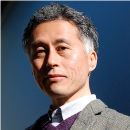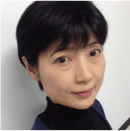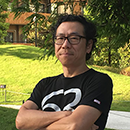Online Contents
オンラインコンテンツ
Onsite Exhibition
リアル展示
- ゲーム作品はオンラインでお楽しみいただけますが、会期中は上野キャンパスでもリアル展示をしています。
感染拡大防止のため、来場者の人数制限を行い、最小限のご案内で開催しています。Webでの事前予約のうえご来場ください。
会期:2023年3月17日〜18日
- The games can be played on this website and they are also available at the onsite exhibition held at Tokyo Geidai’s Ueno campus.
In order to help prevent the spread of COVID-19, the number of visitors is controlled. Please make reservations through the form below.
Onsite exhibition period: March 17-18, 2023
Greetings
ご挨拶
-
-
 桐山 孝司 Takashi Kiriyama
桐山 孝司 Takashi Kiriyama -
東京藝術大学大学院映像研究科長
大学院映像研究科メディア映像専攻教授 Professor, Department of New Media
Dean, Graduate School of Film and New Media
Tokyo University of the Arts
ゲームコース展04の新たな展開
GEIDAI GAMES 04は、2020年9月にオンライン開催となったGEIDAI GAMES 01以来、初めて共同制作のUSCチームメンバーを日本に迎えての開催となります。東京藝術大学とUSCの日米ゲームクリエイション共同プログラムは2018年度からオンラインで行っていたため、コロナ禍でむしろグローバルコラボレーションの真価を発揮することになりました。しかし今回はリアルな会場で直接対話することから触発されることも多いと期待します。
また今回は芸術の中でゲームを活用する新しい展開もあります。大学全体のデジタル技術を推進するアートDXプロジェクトの下で今年度から始まったゲーム制作演習では、薄羽涼彌が学部向けに授業を行なっており、その成果の一部が展示されます。また、博士後期課程の山形一生の研究成果であるFarewellsも展示されます。さらに別会場のアートイノベーションセンターでは、フォトグラメトリーとヴォリュメトリックキャプチャー(4Dスキャン)を使った、かつての横浜市電の体験があります。これらの展示も、これからの芸術の展開にゲームが関わるものとして見ていただければ幸いです。New Directions Presented in GEIDAI GAMES 04
GEIDAI GAMES 04 will be held with the attendance of the team members from USC for the first time since the GEIDAI GAMES exhibition started in September 2020.
The Japan-US Educational Initiative on Creating Games between Tokyo Geidai and USC, which had included online elements since its launch in 2018, turned out to be a good practice for global collaboration in the COVID-19 situation. However, this time, we expect that the dialogue happening in a physical exhibition will bring forth many inspirations.
There are also new components which will be presented at GEIDAI GAMES 04 that bring games into an art context. Under the ArtDX project, which promotes the application of digital technologies in the entire university, Ryoya Usuha started a new course of game production practice for undergraduate students. Some of the results from his class will be exhibited. PhD student Issei Yamagata will be showing “Farewells” as an outcome of his research in the doctoral program. In the Art Innovation Center, an exhibition of an old Yokohama streetcar using photogrammetry and volumetric capture (4D scanning) will be displayed. We would be grateful if you could enjoy these exhibits as new developments of games in the arts. -
-
-
 岡本 美津子 Mitsuko Okamoto
岡本 美津子 Mitsuko Okamoto -
東京藝術大学副学長
大学院映像研究科アニメーション専攻教授 Vice President
Professor, Department of Animation
Graduate School of Film and New Media
Tokyo University of the Arts
A to G (Animation to Games)で思うこと
東京藝大大学院映像研究科ゲームコースでは、アニメーションとゲームの制作共通化を研究する「A to G」を研究テーマの一つとして掲げている。ゲームとアニメーションの制作プロセスや考え方は似ているようで、実はかなりの相違がある。
アニメーションのプリプロダクションの場合、一般的には「絵コンテ」をしっかりと作り、その後、各カット毎の動きや美術のラフを描いた「レイアウト」を作成、その後、「作画」「動画」と進んでいく工程をとる。多くの場合、初期段階からかなり完成形を予想することができる。一方、ゲームの場合は、プロトタイプとプレイテストを繰り返し、その後もバーティカルスライス、α版、β版と段階毎にテストを重ねながら改良していく。テストの結果で内容も変更していくために、最終版は、最初に構想していたものとは異なったものになることも多い。
大学での修了作品の完成版の考え方についてもアニメーションとゲームは大きく異なる。アニメーションの場合、「完プロ」と呼ばれる最終版は、一旦公開された後は一切変更を加えることはない。
一方、ゲームの場合は、大学院での最終版の後に、一般のユーザーを想定した改変とバグ出し作業を行い、リリースされる。更にリリース後もバージョンアップ版やパッチと呼ばれるバグ対応データ配信等が想定される。
アニメーションにおいて、制作の終了とは“本当の作業の終了”であるが、ゲームにおいて、制作の“終わり”というものは無いとも言える。
AとG、この2つの関係は、なかなか奥が深い。Findings on the A to G Project
One of the research themes of the games track at Tokyo Geidai is what we call the A to G Project. We are trying to find common grounds in the production pipelines of animation and games. At first glance, the thought and making processes of animation and games seem similar, but in fact, the divide is quite wide.
Generally, in the preproduction stage of animation, first comes a reliable storyboard followed by layouts which are rough designs for the actions and backgrounds in each scene. Then, the animating begins, usually from keys to inbetweens. In most cases, it is possible to imagine what the final film will look like even in the beginning stages.
On the other hand, when creating a game, the prototype and its later versions are playtested again and again as it develops into a vertical slice, alpha, beta, and so on. Between each step the game is tested and reviewed, therefore sometimes changing its course completely. What it ends up being could be rather different from how it was first planned.
Even the word “finished” has very different connotations in animation and games. In our graduate school, a finalized animation cannot be modified in any way after its release. However, the games students can continue to polish and debug their thesis projects after they are finished for school and prepare them for public release. Many of them go on to make upgrades and patches after the release as well.
In animation, the end of production is the actual end, but in games, there is no end to the production.
The chain of thought that generates when comparing animation to games seems to go on forever. There are many interesting aspects worth pursuing. -
GEIDAI × Industry
産学共同
-
産業界からの教育への参加について
2019年度までは、学生一人につき一名のメンターをスクウェア・エニックス・グループより選出していただいていましたが、昨年度からは手法を変更し、一名のメンターに全学生のプロジェクトを総括的に見ていただく形をとりました。昨年度からメンターを務めていただいている同社プロデューサーの時田貴司氏を、今年度は東京藝術大学特別教授としてお招きし、より密度の高い、多角的なアドバイスをいただいています。
Industry Involvement in Academia
Up until the end of the academic year 2019, one mentor from the Square Enix Group was assigned to each student. A new practice was implemented in 2020 where one mentor gives guidance to all of the students and their projects comprehensively. Producer Takashi Tokita began this new journey with us and has stayed on in 2021 as well. Now appointed as Tokyo Geidai Visiting Professor, Tokita continues to provide advice that is on the mark and eye-opening.
-
-
 時田貴司 Takashi Tokita
時田貴司 Takashi Tokita -
株式会社スクウェア・エニックス プロデューサー 東京藝術大学特別教授
1984年から演劇活動のアルバイトとしてゲーム制作に参加。
デザイナー、プランナー、ディレクターを経て現在はプロデューサーとして従事。
代表作はFINAL FANTASY Ⅳ、LIVE A LIVE、クロノ・トリガー、半熟英雄シリーズ、ナナシ ノ ゲエムなど。 Producer, SQUARE ENIX CO., LTD. Visiting Professor, Tokyo University of the Arts
Tokita began creating games in 1984 as a part-time job while pursuing theater. He has participated in games production as a designer, planner, director, and most recently, as producer. His main projects include FINAL FANTASY IV, LIVE A LIVE, Chrono Trigger, the Hanjuku Hero series, and Nanashi no Game.
新たな世界の在り方、新たな芸夢
ゲームの起源は、成長や生存のシミュレーションと言われます。
手遊び、競技、ボードゲーム。ことにデジタルゲームは時代とともに常に進化し、楽しみ方も多様化しています。
日本ではゲームの域を大きく超え、映画、漫画、アニメと連なってきたエンターテイメントとして、多くのクリエイターが作品を創ってきました。
芸夢魂。
若かりし頃、勢いだけで考えた私の座右の銘です。
長く使ってきた今、意外と良い造語ではないかと自負しています。
心の中から生まれた熱い思いを、趣向を凝らして表現する。
ゲームは作品を共有し、他者、世界と関係していくことができます。
コロナ禍の混沌から緊迫が続く世界情勢ですが、ジャンルや国境を越え、個性あふれるみなさんの芸夢魂。
新たな世界を提示する新たな芸夢を楽しみにしています!A Game Is Art and Dream Combined
The origin of games is said to be the simulation of growth and survival. While there are a variety of games such as fingerplays, sports, and board games, digital games in particular have constantly evolved with the times, and the ways to enjoy them keep becoming more and more diverse. In Japan, games have never been confined to one genre. They have joined hands with film, manga and anime, and have walked together in an entertainment alliance. And many creators contributed to this force with their work.
Art = 芸 (gā)
Dream = 夢 (mo͞o)
Game = 芸夢 (gāmo͞o)
芸夢魂 = The Game Spirit
This is my motto that I conjured up on impulse when I was young. I’ve been using it for a long time now, and it has grown on me as a pretty good coinage. It’s about expressing the spark born out of your heart by pouring everything you have into realizing it. By sharing the game you made, you can connect with other people. The world opens up in front of you. The coronavirus chaos is still binding this planet with tension, but your Game Spirit is one-of-a-kind and free to traverse categories and boundaries. I look forward to seeing new worlds through your games! -
Credits
クレジット
- 主催
- 東京藝術大学大学院映像研究科
- ※文部科学省「大学の世界展開力強化事業 ~COIL型教育を活用した米国等との大学間交流形成支援~」事業として実施
- 協力
-
南カリフォルニア大学映画芸術学部
株式会社スクウェア・エニックス
横浜市文化観光局
東京藝大アートDXプロジェクト
東京藝術大学共創の場形成支援プログラム拠点
- 東京藝術大学大学院映像研究科
- 桐山孝司 岡本美津子 松本祐一 江口麻子 牧奈歩美
薄羽涼彌 伊藤圭吾 吉野範子 久保田勇 西川順子
- 東京藝術大学国際企画課
- 豊嶋美穂子 藤井基城
- 株式会社スクウェア・エニックス
- 時田貴司
- 南カリフォルニア大学映画芸術学部
- アンドレアス・クラッキー ピーター・ブリンソン
- メインビジュアル
- 付美君(東京藝術大学大学院映像研究科ゲームコース)
- Organized by
- Tokyo University of the Arts Graduate School of Film and New Media
- Cooperation
-
University of Southern California School of Cinematic Arts
SQUARE ENIX Co., Ltd.
City of Yokohama Culture and Tourism Bureau
Tokyo Geidai ArtDX Projects
Tokyo University of the Arts COI-NEXT
- Tokyo University of the Arts Graduate School of Film and New Media
-
Takashi Kiriyama Mitsuko Okamoto Yuichi Matsumoto
Asako Eguchi Nahomi Maki Ryoya Usuha Keigo Ito
Noriko Yoshino Isamu Kubota Yoriko Nishikawa
- Tokyo University of the Arts International Initiatives Planning Section
- Mihoko Toshima Motoshiro Fujii
- Square Enix
- Takashi Tokita
- University of Southern California School of Cinematic Arts
- Andreas Kratky Peter Brinson
- Key Visual
- Meijun Fu (Tokyo University of the Arts Graduate School of Film and New Media)

